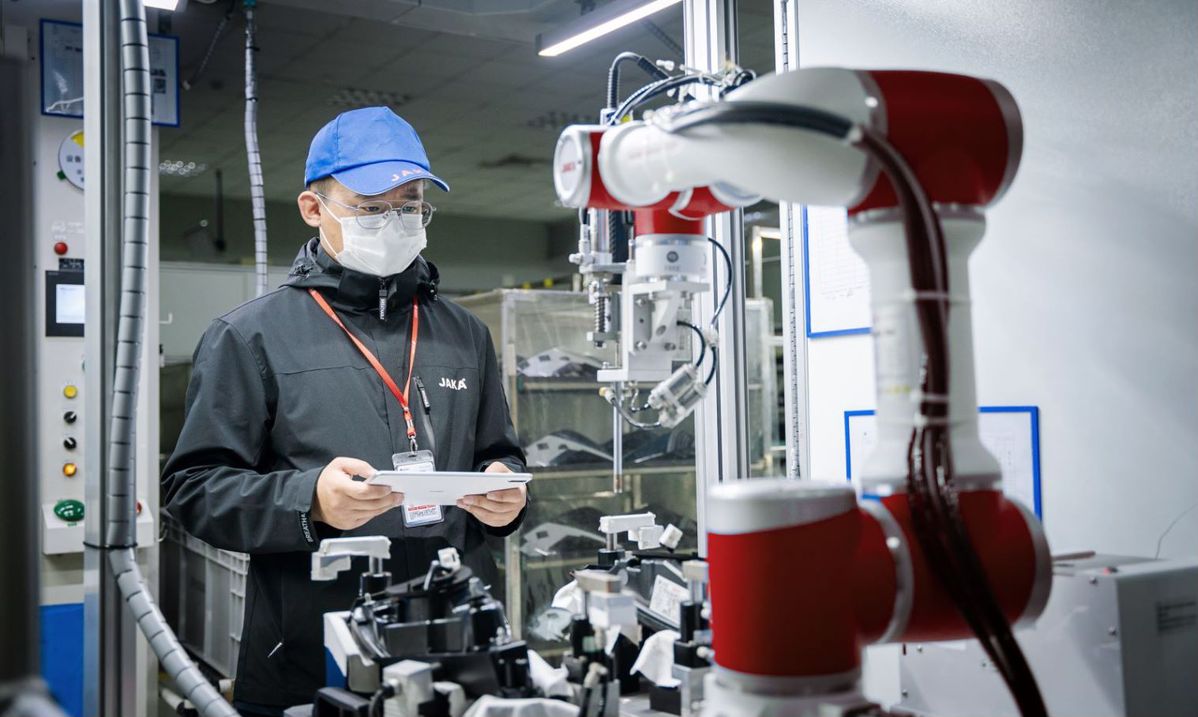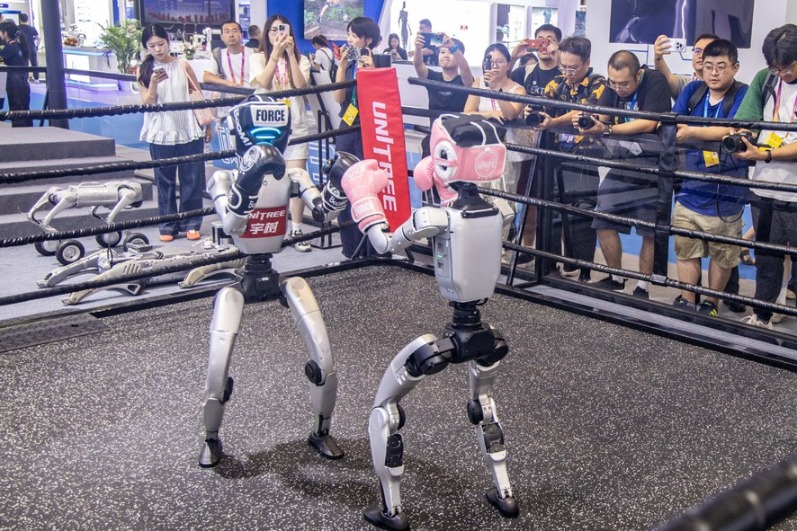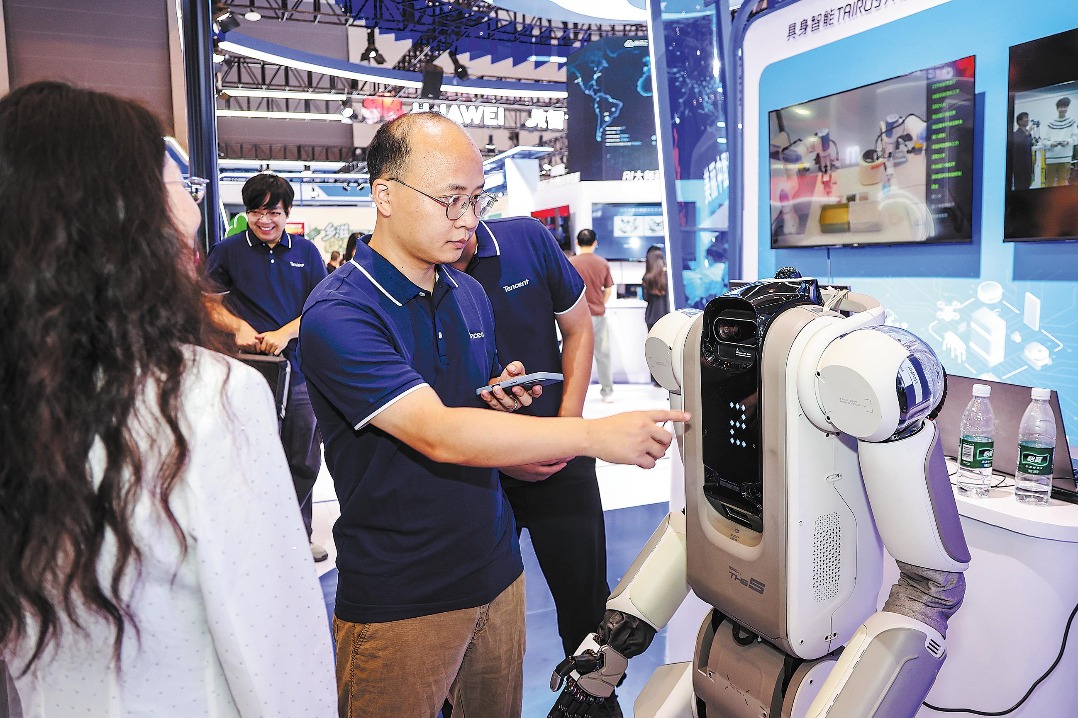Humanoid robots play more roles
People-machine interactions gaining greater ground as smart tech evolves


These days, robots can help you make a latte sporting a perfect creamy tulip pattern.
With six-dimensional force control and high-precision algorithms, they now boast increasingly impressive self-learning and decision-making capabilities.
Chang Li, vice-president of JAKA Robotics Co Ltd, said that the company has developed collaborative robots possessing stronger self-learning abilities, self-decision-making capabilities and human-machine interactions.
"These intrinsic technological advances allow robot control through drag-and-drop and point teaching in practical scenarios, lowering the usage threshold and truly freeing frontline workers' hands to engage in more valuable and creative work," said Chang.
JAKA Robotics, which specializes in the new generation of collaborative robots and smart factories, has expanded its business into multiple industrial and service scenarios.
Founded in 2014, JAKA Robotics transforms robots from specialized equipment into easy-to-use tools, emphasizing flexibility and intelligent collaboration. The company has pioneered innovations in various applications, including drive control integration, integral joints, free-drive programming and wireless connectivity.
JAKA Robotics offers a modular, self-developed platform, achieving rapid product iteration through hardware and software technology research and development for perception and decision-making with its body algorithms, application algorithms and Over-The-Air (OTA) cloud system.
JAKA's production base is located in Changzhou, Jiangsu province, thus leveraging the industry cluster advantages of the Yangtze River Delta region.
The company has achieved self-research and production of the core parts of the robot, ensuring stringent quality control and testing from parts production to whole-machine testing.
"This approach realizes 'robots making robots', empowering factories across various industries to upgrade intelligently. Innovation is the genome and foundation of JAKA Robotics," Chang added.
Currently, the company has developed a core technology system encompassing intelligent modular joints, high-quality motion control, new teaching, rapid deployment, human-machine intelligent integration, safety collaboration, intelligent production lines and integration.
From everyday thermos cups and the first national AI cafeteria to auto parts manufacturing and the cleaning of the "Sky Eye" radio telescope, JAKA Robotics has driven innovation over the past decade, converting technological achievements into market applications.
Press-fit technology is widely applied in multiple automotive applications. For example, automotive pin processing, which traditionally relied on manual labor, had faced issues such as low production efficiency, inconsistent processing levels and long on-site modifications.
JAKA's fully automated pin processing workstation integrates components like motors, drives, controls, reducers and dual encoders into the robot body, achieving miniaturization and enabling installation in small spaces.
The company has worked with Toyota Group, deploying hundreds of JAKA collaborative robots on multiple production lines in Toyota's auto parts manufacturing plants. These robots perform tasks such as three-pin grinding, inner star wheel grinding, small part processing, loading and unloading, screw locking, inspections and assembly. Additionally, they have launched an automatic charging application for new energy vehicles, helping global brand Lotus achieve intelligent charging.
JAKA Robotics has invested in the business to serve industrial applications in automotive, electronics, semiconductors and new energy sectors, as well as engaging in direct consumer service work in various new commercial consumer fields.
The company is also looking to expand business overseas in Japan, Southeast Asia and Europe.
To enhance innovation, JAKA Robotics promotes integration of production, education and research. The company has formed cooperative relationships with many universities, including Shanghai Jiao Tong University, focusing on both hardware and software research in robotics.
Moreover, the company founded JAKA Academy, creating a dual-teacher classroom that connects enterprises and schools. This initiative provides innovative practice platforms for enterprises and higher education institutions. Currently, R&D personnel account for over 25 percent of JAKA Robotics' employees.
Liang Rui, president of Shanghai Step Robotics Co Ltd, said with the quality and quantity of all the suppliers from the Yangtze River Delta region, the localization process is accelerating and China's industrial robot market is entering a golden era.
"This Yangtze River Delta region is the most concentrated area for the industrial robot industry in China, with a progressively complete industry chain," Liang said.
He added that last year, the overall market growth for industrial robots in China was flat, but domestically produced robots have seen an average growth of around 25 percent over the past two years.
"The gap between medium and small-sized robotics with international peers is shrinking. In the next three to five years, large-sized robotics will be the key field to grow for domestic players," said Liang.
Both JAKA and Step are vivid examples of the emerging power in the field of the humanoid robot sector, incubated in Shanghai. The city is actively developing relevant policies to support breakthroughs in key technologies such as humanoid robot bodies, embodied intelligence models and more dexterous hands.
The goal is to deepen the application of humanoid robots in industrial manufacturing and service sectors, striving to achieve a scaled application demonstration of 1,000 units within three years, said the Shanghai Economic and Informatization Commission.
Additionally, Shanghai is accelerating the drive to realize the deployment of 10,000 intelligent robots in smart factories. By 2025, the target is for the density of robots in key industries to reach 500 units per 10,000 people.
wangzhuoqiong@chinadaily.com.cn




































